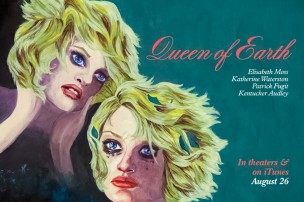
Alex Ross Perry’s “Queen of Earth” is a sharp, nettled, visceral movie that probably needs a second viewing to really sink in, but which is absolutely worth that first viewing to familiarize yourself with the territory. Elizabeth Moss plays the character Catherine, while Katherine Waterston plays Ginny. Catherine’s brilliant artist father kills himself and her boyfriend leaves her, stripping her life of its masculine loci. She’s downward-spiraling, trying to recuperate at her friend Ginny’s idyllic lake house. The two snarl and tear at each other through a series of escalating verbal duels and duets, as Catherine slides deeper into a spiteful, near-nuclear depression, and Ginny eggs her on. The toxic interpersonal dynamics—who’s hurting who more, who really loves who, who’s scheming and who’s hallucinating— remain cloaked in a thick layer of ellipses and ambiguity. This can be compelling and mysterious, and it is through most of the 90 minutes.
However, for the movie to have any success at all, the viewer has to make the decision to get on its wavelength. The work can feel like an experiment in being off-putting and cold, as opposed to something organically off-putting and cold. To clarify, imagine Lou Reed’s “Metal Machine Music.” The album is over an hour of nothing but modulated guitar and feedback effects, nightmarish and aggressive and prankish. It’s perversely admirable and perversely pleasurable, and the man himself, Lou Reed, is doing it, so you have to admire his chutzpah. But it’s still a task to listen and enjoy.
Now imagine a young, similarly perverse and very talented artist deciding to make her own “Metal Machine Music.” You admire the chutzpah, but in listening you can feel the seams and cracks where the artist bends herself toward Lou Reed and his effects pedals, and this adds a distancing layer of abrasion. Apply the same formulation while replacing Lou Reed with a schizoid German like Rainer Werner Fassbinder or an ice cold Swede like Ingmar Bergman, and that’s what “Queen of Earth” can feel like. But the film’s unintentional stiltedness is in its own way perversely admirable because the viewer can feel new ideas being tried out, new ways of framing scenes and new methods of performance and dialogue delivery being worked out at this vacation house.
We’re talking about what is first and foremost a deeply entertaining, gripping movie, even if it’s not about pleasant people, places or ideas. It doesn’t need to be a great one. Greatness is a relative and probably meaningless term, especially when used in relation to movies, but if anything in “Queen of Earth” could be termed capital-G Great, it would be the performances.
Katherine Waterston is lean, languorous, and feline. At one point she declares herself a member of a contemporary aristocracy. Lines like this litter the dialogue, but Waterston makes them work by gliding them out into the scene offhandedly, so they take a moment to impact and then dissipate. This sly method of play makes her a terrific sparring partner for Moss’ absolutely devastating nuclear warhead of a character. At one point Moss describes a character as the reason depression exists and the reason there are no safe places in the world. It’s amazing. Put it this way: Waterston’s slinky cat-in-the-sun way of moving renders her almost literally as a cat in the sun. Moss, on the other hand, is anti-metaphorical. Monumental and at the same time lively, she cuts through the occasionally premeditated-feeling but nonetheless deeply enjoyable “woman going insane” horror film quotations (a gorgeous giallo-humping soundtrack, fun games with split diopter lenses and slow zooms, jagged editing style), to ground the film in this specific woman and her specific pain. “Queen of Earth” is bleakly and ferociously alive.


Leave a Reply